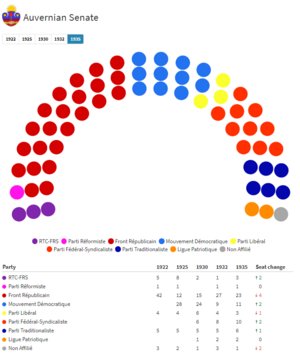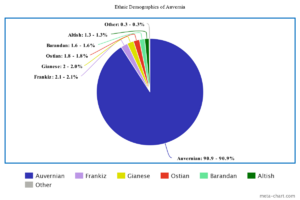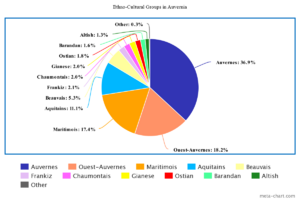Auvernia: Difference between revisions
| (5 intermediate revisions by the same user not shown) | |||
| Line 351: | Line 351: | ||
!align="left" width="15%"|Affiliation | !align="left" width="15%"|Affiliation | ||
|- | |- | ||
|colspan=8 style="background-color:#C0C0C0;"|<center>[[File:Emergency Gov t Chevron.png|50px]] <big>'''Supreme Leader of | |colspan=8 style="background-color:#C0C0C0;"|<center>[[File:Emergency Gov t Chevron.png|50px]] <big>'''Supreme Leader of Auvernia'''</big> [[File:Emergency Gov t Chevron.png|50px]]</center> | ||
|- | |- | ||
|align="center" |[[File:Robert Georges Nivelle.jpg|150px]]<br>'''[[Jean-Claude de Valmère]]'''<br><small>(1856-1929)</small> | |align="center" |[[File:Robert Georges Nivelle.jpg|150px]]<br>'''[[Jean-Claude de Valmère]]'''<br><small>(1856-1929)</small> | ||
| Line 404: | Line 404: | ||
===List of Heads of Government of Auvernia=== | ===List of Heads of Government of Auvernia=== | ||
See main article: [[List of Heads of Government of Auvernia]] | |||
====Second Imperial Era==== | |||
(1841-1925) | |||
'''Key:'''<br> | |||
{{legend2|#f81937|[[Radical Republicans (Auvernia)|Radical Republican]]|border=1px solid #AAAAAA}} {{wp|Republicanism}}, {{Wp|Social liberalism}} <br> | |||
{{legend2|#FA8072|[[Moderate Republicans (Auvernia)|Moderate Republican]]|border=1px solid #AAAAAA}} {{wp|Constitutional monarchy}}, {{Wp|Social liberalism}}<br> | |||
{{legend2|#ffbf00|[[Clementinism (Auvernia)|Clementinist]]|border=1px solid #AAAAAA}} {{wp|Bonapartism|Clementinism}}, {{Wp|Imperialism}} <br> | |||
{|class="wikitable" width="100%" | |||
!align="left" width="5"|No | |||
!width="100"|Portrait | |||
!align="left" width="10%"|Term | |||
!align="center" colspan="2" width="20%"|Term | |||
!align="left" width="10%"|Mandate | |||
!align="left" width="10%"|Affiliation | |||
!align="left" width="10%"|Overview | |||
|- | |||
|colspan=8 style="background-color:#C0C0C0;"|<center>[[File:Coccarda FRANCIA.svg|50px]] <big>'''President of the Chamber of Deputies'''</big> [[File:Coccarda FRANCIA.svg|50px]]</center> | |||
|- | |||
|align="center" |{{color|black|'''1'''}} | |||
|align="center" |[[File:François Arago by Carl von Steuben.jpg|100px]]<br>'''[[Jean Cazalet]]'''<br><small>(1786 - 1853)</small> | |||
|align="center" style="background: #f81937;"|{{color|black|'''Single term'''}} | |||
|align="center" |<small>17th of October, </small><br>1841 | |||
|align="center" |<small>28th of October, </small><br>1846 | |||
|align="center" |''Republican minority government'' | |||
|align="center" |Radical Republican | |||
|align="center" |After the elections of 1841 called by Emperor Pierre III, the Clementinists had a weaker showing than anticipated leading to them being unable to bring enough moderates on board to form a government. Instead Jean Cazalet, a political powerhouse among the republicans greatly popular in Auvernia manages to pull together a minority government that despite being radical in its orientation is willing to work with Pierre III. When Pierre IV demands an oath of loyalty in 1846, Cazalet refuses and opts not to run for another term. | |||
|- | |||
|align="center" |{{color|black|'''2'''}} | |||
|align="center" |[[File:Scheffer Cavaignac.jpg|100px]]<br>'''[[Samuel Cognac]]'''<br><small>(1802-1857)</small> | |||
|align="center" style="background: #FA8072;"|{{color|black|'''Single term'''}} | |||
|align="center" |<small>17th of October, </small><br>1846 | |||
|align="center" |<small>19th of July, </small><br>1852 | |||
|align="center" |''Republican minority government'' | |||
|align="center" |Moderate Republican | |||
|align="center" |Elected from among the Moderate Republicans after they gained the most seats. Initially boasting strong relations with Pierre IV and wishing to bolster the power of the Chamber of Deputies, disputes over war strategy in the ongoing West Nymerian Crisis of 1850. The result was Cognac denouncing Pierre IV a strategically incapable and Pierre IV in return dismissing Cognac as President. Snap elections were held in August after the minority government failed to agree on a new President within the twenty one day window. | |||
|- | |||
|align="center" |{{color|black|'''3'''}} | |||
|align="center" |[[File:Lannes, Napoléon.jpg|100px]]<br>'''[[Alan Pierre Laurent]]'''<br><small>(1801-1874)</small> | |||
|align="center" style="background: #ffbf00;"|{{color|black|'''Single term'''}} | |||
|align="center" |<small>22nd of August, </small><br>1852 | |||
|align="center" |<small>2nd of September, </small><br>1857 | |||
|align="center" |''Clementinist majority government'' | |||
|align="center" |Clementinist | |||
|align="center" |After a strong showing in the August 11th snap election, the Clementinists managed to win a majority of seats in the Chamber of Deputies but were divided over who to select as their President. After a week of deliberation they settled on Alan Pierre Laurent, son of the Clementinist Wars marshal Alan Laurent and a personal friend of Pierre IV. President Laurent was highly supportive of the Imperial agenda but opted against running for re-election instead intent on serving as president of the Imperial Academy starting in 1857. | |||
|- | |||
|align="center" |{{color|black|'''4'''}} | |||
|align="center" |[[File:Charras (V. Rose).jpg|100px]]<br>'''[[Didier H. Ballard]]'''<br><small>(1810-1865)</small> | |||
|align="center" style="background: #FA8072;"|{{color|black|'''Single term'''}} | |||
|align="center" |<small>22nd of August, </small><br>1857 | |||
|align="center" |<small>8th of April, </small><br>1860 | |||
|align="center" |''Republican majority government'' | |||
|align="center" |Moderate Republican | |||
|align="center" |A retired brigadier general and deputy for Sancy, President Ballard was elected in the strongest showing by republicans only straying four seats from forming a majority government. Nonetheless enough crossbencher non-inscrits voted along with his government that his government functioned as a majority government would. His policies included increasing colonial investments, public schooling and rural infrastructure. A major believer in internal improvements, Ballard's administration also invested in experimental technologies such as the railroad and telegraph. Ultimately, a scandal in which Ballard was found to be attending meetings with exiled radical republicans caused monarchists within his faction to demand that he step down and ultimately to the Emperor dismissing the government and calling an election. | |||
|- | |||
|align="center" |{{color|black|'''5'''}} | |||
|align="center" |[[File:Eugène Rouher painted by Alexandre Cabanel, ca. 1861.jpg|100px]]<br>'''[[Emmanuel Montauban]]'''<br><small>(1814-1884)</small> | |||
|align="center" style="background: #ffbf00;"|{{color|black|'''Single term'''}} | |||
|align="center" |<small>20nd of April, </small><br>1860 | |||
|align="center" |<small>1st of May, </small><br>1865 | |||
|align="center" |''Clementinist minority government'' | |||
|align="center" |Clementinist | |||
|align="center" |A staunch Clementinist, President Montauban strengthened sedition laws in retaliation for the Ballard scandal leading to Ballard's exile from Auvernia. Despite this he continued most of Ballard's domestic priorities and built on them by supporting the establishment of a national railway network to connect all rail lines in Auvernia. He declined to run for an additional term when the election of 1865 loomed near. | |||
|- | |||
|align="center" |{{color|black|'''6'''}} | |||
|align="center" |[[File:Troplong par Petit.jpg|100px]]<br>'''[[Richard L. Promeneur]]'''<br><small>(1795-1868)</small> | |||
|align="center" style="background: #ffbf00;"|{{color|black|'''Single term'''}} | |||
|align="center" |<small>20nd of April, </small><br>1865 | |||
|align="center" |<small>17th of December, </small><br>1868 | |||
|align="center" |''Clementinist majority government'' | |||
|align="center" |Clementinist | |||
|align="center" |An artist, composer and academic, Richard Promeneur was a personal friend of Emperor Pierre IV and it was at his beheast that the Clementinist faction nominated him to serve as their candidate for president. The result was a popular presidency in which Promeneur would debate the opposition at length in parliament and rallied support for investment in the fine arts, imperial expeditions in Nymera and Tellures leading to colonial exhibitions in Nanterre in 1867 and 1868. Aside from this major naval investments were made and the economy fared well seeing stable growth under a policy of public investiture and limited mercantilism. However, in November of 1868 President Promeneur contracted tuberculosis leading to his health failing to the point of infirmity and his death on December 17th, 1868. | |||
|- | |||
!rowspan="3" align="center"|{{color|black|'''7'''}} | |||
!rowspan="3" align="center" |[[File:Adrien Marie Devienne (1858-1869).jpg|100px]]<br>'''[[Pierre de Saverne]]'''<br><small>(1849-)</small> | |||
|align="center" style="background: #ffbf00;"|{{color|black|'''1'''}} | |||
|align="center" |<small>19th of March, </small><br>1868 | |||
|align="center" |<small>18th of March, </small><br>1870 | |||
|align="center" |''Clementinist majority government'' | |||
|align="center" |Clementinist | |||
|align="center" |A political philosopher, member of the supreme court and member of the nobility, Pierre de Saverne was selected to succeed Promeneur. A major revanchist, monarchist and imperialist the first de Saverne administration saw massive military and colonial investment and the outbreak of the [[First Nāngai War]] (1869-1871). | |||
|- | |||
|align="center" style="background: #ffbf00;"|{{color|black|'''2'''}} | |||
|align="center" |<small>19th of March, </small><br>1870 | |||
|align="center" |<small>19th of March, </small><br>1873 | |||
|align="center" |''Clementinist minority government'' | |||
|align="center" |Clementinist | |||
|align="center" |Receiving lackluster results in the 1870 election, President de Saverne struggled to get his policies implemented during his second administration leading to him calling elections in 1873 amid infighting among the republicans. | |||
|- | |||
|align="center" style="background: #ffbf00;"|{{color|black|'''3'''}} | |||
|align="center" |<small>19th of March, </small><br>1873 | |||
|align="center" |<small>19th of March, </small><br>1881 | |||
|align="center" |''Clementinist majority government'' | |||
|align="center" |Clementinist | |||
|align="center" |Receiving an electoral supermajority, the third de Saverne administration WIP | |||
|- | |||
|} | |||
====Second Republican Era (1927-)==== | ====Second Republican Era (1927-)==== | ||
Latest revision as of 14:20, 20 March 2024
This article is incomplete because it is pending further input from participants, or it is a work-in-progress by one author. Please comment on this article's talk page to share your input, comments and questions. Note: To contribute to this article, you may need to seek help from the author(s) of this page. |
The Second Auvernian Republic La Deuxième République Auvernien | |
|---|---|
| Motto: Vive la République | |
| Anthem: 'Chant de la liberté' | |
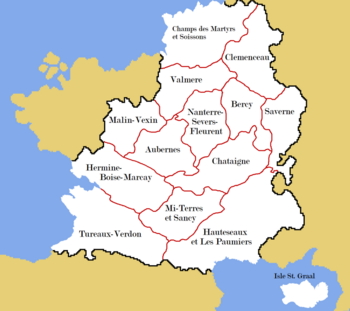 Auvernian Regional Departments | |
| Capital and largest city | Nanterre |
| Official languages | Auvernian |
| Ethnic groups | Auvernian (94%)
Frankiz (2%) Altish (1.5%) Gianese (1.1%) Barandan (0.6%) Other (0.8%) |
| Demonym(s) | Auvernian |
| Government | Semi-Presidential Republic |
• President | Clément Sartre |
• Prime Minister | Charles Maçay |
| Legislature | National Congress |
| The Senate | |
| The Assembly | |
| History | |
• An Independent Kingdom | 729 |
• The First Revolution | March 15th, 1791 |
• The Ascension of Emperor Pierre Clement | June 18th, 1799 |
• The Clementine Restoration | March 10th, 1822 |
• The Nanterrian Commune | March 15th, 1891 - June 2nd, 1892 |
• The Great War Begins | 1912 |
• The Second Revolution | May 8th, 1925 |
| Population | |
• 1930 estimate | 56,550,000 |
| Currency | Auvernat (AVT) |
| Time zone | NST |
| Driving side | right |
| Calling code | 33 |
Auvernia, officially the Second Auvernian Republic (Auvernian; La Deuxième République Auvernien), is a sovereign nation located in northern Cybella. Auvernia is bordered by the United Provinces to her north, Altenland, Hercynia and the Holy Aventine Empire to her East and !Iberian States to her south. The population of the country is largely suburban and distributed throughout its vast lands. The most populous areas are the Centre-Auvernie followed by Maritimie and Sud-Ouest, the center of Auvernia is less densely populated with a few industrial centers scattered throughout the various mountainous, forested and plains regions. Aside from these industrial centers, much of central and eastern Auvernia is rural and marked by large national parks and historic sites. Auvernia is a Semi-Presidential republic with Nanterre serving as its capital and largest city. Nanterre doubles as the nation's economic hub and cultural and commercial centre. Auvernia has a separation of powers between its Executive, Judicial and Legislative branches, and is a secular, although majority Catholic state based upon the principles of popular sovereignty, republicanism, and national unionism.
Auvernia exists in what had been several Aventine provinces prior to the age of Migration and the arrival of the Auvernian tribesmen in the 700s AD. Administered as an imperial province of the Aventine Empire, Auvernia remained an integral province until the Auvernian tribes settled the region overrunning the Aventine armies and over the centuries carving out an independent dominion. The nation formally was founded by King of the Auvernes Conrad Savian in 737 AD. Over the centuries after its founding, the Auvernian Kingdom expanded many times in size, growing to become one of the largest Cybellan and world powers. Later, in 1791, the First Auvernian Revolution would begin ending in the execution of the royal family and proclamation of the First Auvernian Republic. However, the first republic was highly unstable and eventually saw the rise of famed general and lawyer Pierre Clement who in 1799 declared himself emperor of Auvernia in the Senate in a famous event known as the Ascension of Pierre Clement. As Emperor Pierre would transform the legal and military system for Auvernia and lead the nation into the Clementine Wars, most notably culminating in the Auvernian-Aventine wars which would see the decline of Aventine dominance in Western Cybella. After Pierre's death, his son Charles Clement reigned as a pragmatic administrator until his untimely death in 1822. Facing a disputed succession, the country fell into turmoil and saw foreign interventions in political affairs leading to the restoration of the old royal family. Through the 19th century, the Kingdom of Auvernia struggled to suppress several Republican, Clementist and, later, Communist revolts in the country. Despite this, the Kingdom remained one of the foremost geo-political forces with the largest standing navy in the world. This ended after the disastrous Great War which ended in an effective stalemate. The social and economic turmoil which followed in the early 1920s led to the Second Auvernian Revolution in 1925. The Revolution was composed of a united front of workers militias and veterans who no longer recognized the legitimacy of the monarchy nor the ability of the current government to care for the people. The Revolution was swift, but the Provisional government was extremely divided, appointing a member of the Socialist International Front as its head of state despite broad right wing opposition. The result was the Red Terror which saw a second purge of the Royal Family and of nobility and as a result, the Auvernian Civil War in which several formerly Royalist and Revolutionary forces merge into the United National Front which was a Conservative Syndicalist militiant organization. Mass defections from the military and the rise of conservative workers militias in the South and West allowed led to a protracted nearly three year civil war. In the last few months, the Socialist forces lines began to collapse under stress as the state had become a pariah in Cybella facing embargoes and enforced isolation, the United National Front took Nanterre and Marshal Anton Rousseau who declared a new provisional government known as the Auvernian State. For nearly a year he effectively served as Head of State and Government before announcing elections on March 15th of 1930. In the first election the National Republican party won making Charles Maçay President. In the aftermath of his election he transformed the government into a Constituent Assembly and for two years the government has worked on drafting a National Constitution to finalize the creation of an Auvernian Federation. Upon its ratification, Charles Maçay has vowed to allow snap elections which he does not wish to participate in. Therefore the direction of Auvernia is considered very open to change as the nation enters the 1930s.
Etymology
Auvernia takes its name from the Ancient Auvernian Tribes which settled the region in the 8th Century AD. The tribes, which had migrated into the region from what is now the South-Western portion of Altenland, were named the Auvernians by the Aventine Empire after their legendary warrior-king Auvernac. Auvernac in turn took his name from a denonym used to denote the noble family which led his tribe.
History
Antiquity
Aventine Era
Foundation
(For further reading, see articles: Auvernac, Auvernian Invasion, and Auvernian Confederacy)
The modern Auvernian state claims continuity dating back to Auvernia's independence from the Holy Aventine Empire in the year 719 AD when a massive invasion of Altic and !Celtic tribesmen led by the legendary warrior-king Auvernac crossed the Coult river and captured the city of Nanterre later that year. In the months following Auvernac rallied rebellious tribes in the north of the region and forced others in the south into submission. With his combined forces of Alts, !Celts, and !Gauls Auvernac defeated the Aventine Armies in several major battles throughout the northern and central regions of what now is Auvernia between the years of 719 and 722 before reaching a peace settlement. In the years after his victory he established a tribal confederacy and settled more his tribesmen around the city of Nanterre which he declared the capital on July 10th, 724.
In the spring of 725 hostilities resumed as a large Aventine force was sent to recover the lost territories, and Auvernac's younger brother Aurelac was defeated and died in the mid-summer battle of Fourcès. Despite this loss, the Auvernian confederacy mustered a massive army, this time led by Auvernac himself, and utilizing hit and run tactics gradually weakened the Aventine forces before decisively defeating them in the battle of Verdon-sur-Mer in 726. In the year 727 a final peace settlement was agreed upon between representatives of the Aventine regency and King Auvernac leading to a century of peace between the two parties. With this agreement, said to have been made on the 19th of October, Auvernia had gained its independence.
King Auvernac reigned for twelve years after this victory, in his last year of life in declining health he formally converted to Epiphianity before, later that year dying peacefully in his sleep. He was succeeded by his son Alburix who shortly thereafter took the regal name Auvernius, establishing the Auvernian Kingdom in his coronation ceremony which was held at Frontignan in 739 AD. The ceremony featured an oathbinding ceremony in which his vassals swore their loyalty to King Auvernius and to defense of his realm.
The Auvernian Kingdom
(For further reading, see main article: Kingdom of Auvernia)
The Old Auvernian Dynasty
The Old Auvernian Dynasty reigned from the year of Auvernius until the reign of Charles I when the line became extinct in the year 991. The Old Auvernian Dynasty is characterized by its high support for the Aventine Church, conversion of heathenry, and the total transition from early manorialism towards feudalism. Notable monarchs include Stephen II, Geoffroi 'the Venerable', Stephen V 'the Lion of Epiphanes', and Guiscard 'The Great'. After the reign of Charles I who fathered no sons, the main line became extinct and a cadet branch adopted the name of the parent branch, though it is distinguished as the New Auvernian Dynasty.
The New Auvernian Dynasty
The New Auvernian Dynasty reigned from the year 981 until 1652 and is characterized by its expansionism and both for its support of the early Catholic crusades, and later for its division with the Aventine Church. Its notable rulers are its first king, Stephen VI, as well as the Crusader Kings Philippe I and Albert I.
The Supremacy Controversy and the Catholic Church of Auvernia
King Laurent II, responsible for the 'supremacy controversy' in which the Kingdom ceased to acknowledge the authority of the Pope while maintaining doctrinal cohesion, King Albert II who restored ties with the Papacy in 1487 and King Étienne I who in 1561 renewed the split with the papacy instead endorsing the doctrines of the excommunicated Bishop of Valmere, Philippe Bodin.
The Bodinist Period
Colloquially known as Bodinisme, Bodin's teachings rejected free will and declared that those saved by divine salvation are elect "according to the foreknowledge of God the Father." The doctrine was deeply divisive in Auvernia, on one hand the common folk and several major noble families protested the major deviation from Catholic dogma. However, the burgher class and nobles concentrated around Nanterre had long been sympathetic to Bodin's teachings and hence when King Étienne I announced his conversion celebrations were held in the bourgeois quarter in Nanterre and other large cities. Though in the Edict of Nanterre, which King Étienne I issued in 1566, aimed to create an official state policy of religious tolerance, throughout much of Auvernia and Reynland tensions grew to a boiling point and several revolts occurred including the Canterbury and Palmiers rebellions of 1569 and the Great Revolt of 1571. While unsuccessful, these revolts led to the King ceding many rights to local nobles and becoming increasingly dependent on the financial support of the burgher class and Bodinist Church which both gained significant influence within his administration.
King Étienne I died aged 68 in 1573 and his dole son, who was crowned as King Albert III was coronated in the first ever non-Catholic coronation ceremony in Auvernian history. The lack of the presence of the Catholic Arch-Bishop of Nanterre led to many noble families in the south and west of Auvernia to outright reject his legitimacy and instead endorsed his uncle's cadet branch of the New Auvernian dynasty, the House de Verdon. King Albert III was plagued by illness and was not of great stature, however he had a sharp mind and carefully managed the Auvernian realm during his twenty one year reign. However, facing overwhelming opposition by the nobility of Reynland who had long loathed the revocation of their parliamentary rights King Albert III conceded to their 1587 Petition for Redress of Grievances by issuing the Parliamentary Restoration Act of 1589, autonomy was restored to Reynland. Though this gained him the support of the Reynish nobility, it only further alienated the Auvernian Catholic nobility who believed that he had forced the dual kingdom onto the path towards division.
The War of Auvernian Succession
After the death of King King Étienne II, a regency began for his sole heir Georges who was only four years old at the time of his father's passing. Prince Georges Regency council consisted of several Bodinist bishops, nobles and
The House de Verdon
After usurping the throne in 1652, the capital was moved to Verdon, and the House of Verdon reigned until the Revolution of 1791. The House re-aligned itself with the Holy Aventine Empire and accelerated the colonization of Hibernia and the !Caribbean. Notable rulers include its founder Guillaume 'the Reighteous' as well as Henri III 'The Great', Auvernius II 'The Grand' and Philippe II 'The Feeble'. The latter of the four's economic program, poor statesmanship and military failures are widely considered to be greatly responsible for the Revolution of 1791.
History of Auvernian Colonialism
(For further reading, see main article: History of Auvernian Colonialism)
The Revolution of 1791
(For further reading, see main article: Auvernian Revolution of 1791)
After two winters of famine, military losses and diplomatic debacles making Auvernia appear to be the sick man of Cybella, philosophers had begun calling for a new government modelled after the old Aventine Republic. Soon military support, and even lower nobility began to emerge for reform, and the masses, exhausted from years of economic recession and hardship rose up in open rebellion. With the support of veteran military units and even defectors from the royal guard, on June 12th of 1791 Nanterre was quickly overrun and became the center of the revolution. Soon other major cities fell and a Constituent Assembly was organized and with only minor skirmishes, on October 10th later that year, the King surrendered to the Constituent Assembly and on November 2nd a Constitutional Monarchy was proclaimed. Elections were set for the day before Noël and with a mild winter setting in, turnout was considerably high. A Liberal government was elected to the dismay of both radicals and reactionaries and it quickly became deeply unpopular for its lack of action.
In early May that year, a plot by the supporters of the King's authority to restore his absolute power was made public and radicals marched out into the streets across the nation. In a fit of rage, they stormed the Royal Quarters and seized the King and his adult children, holding a mob trial and lynching them in the streets of Verdon. The ringleader of the mob, Guillaume Roux organized a new government known as the Social Committee, inviting radicals from across Auvernia to join. Divided on how to respond, the Constituent Assembly quickly lost its legitimacy as revolutionary militias began to defect to the side of the Social Committee. The Social Committee banished all Liberal and Reactionary members of the Constituent Assembly and arrested many notable royalists.
A Constitution, known as the Charter of the Rights of Citizens was signed on the 1st of June by many notable revolutionaries and The Auvernian Republic was proclaimed on June 4th. As enlisted men favored the new government which promised them all increased benefits and rights, soon many generals had sworn allegiance to the new administration and the Republic consolidated power in itself.
The Republic of Auvernia
(For further reading, see main article: Republic of Auvernia)
With the Republic established on the 4th of June, 1792, the Revolutionaries had found themselves at the head of a constituent assembly, and immediately got to work on drafting resolutions to add to the Constitution to form the structures necessary for a functional Republican government. However, within a few days two factions had emerged, Roux's dominant faction, known as the Radicals, and a smaller but still influential faction headed by Philippe Claude known as the Claudists who opposed any strong power being vested in the new Republic. Due to their influence, the issue of having a Head of State became a central issue of debate. Due to this, on June 20th the Auvernian Republic held a plebiscite on whether separation should exist between the Executive and Legislative branches, and ultimately the plebiscite rejected the establishment of an Executive Branch. Instead an Executive body known as the Directorate was established to handle any executive affairs, while the National Assembly was tasked with legislative matters.
Revisions to the Charter concluded on the 22nd of June, and could not have come sooner as a Royalist rebellion had begun in Southern Auvernia. Led by a nobleman Laurent de la Croix, the revolt quickly overran Auvernian republican garrisons in the region, and soon regiments began to defect to the side of the Royalists. The Republicans were slow to react, but eventually gathered a sizable force led by young revolutionary general Pierre Clement. The force defeated the Royalists handily and forced Laurent and several prominent backers of the revolt into exile in the Aventine Empire. This created a great deal of outrage among the revolutionary leaders, and started to build tension between the Republic of Auvernia and the Aventine Empire which refused to hand over royalist dissidents.
However, by October of 1792, the Republic had fallen into bitter partisanship as Claudists refused to expand military spending, seeing the Radicals and generals aligned with that political faction as being a potential threat to the liberties of Auvernian citizens. However, using intimidation, the Radicals managed to force through a new budget which not only increased military spending but also strengthened sedition laws. This led to riots in Nanterre and other major Auvernian cities as protests against Guillaume Roux and his Radicals were at times violently suppressed. Heavily worded letters were exchanged by the two Republican figures leading to a bitter rivalry, and tensions boiled over after Henri Chaumont, a prominent Claudist Assemblyman made a public speech on the 22nd of October calling the Radicals "Monarchists without a King". As being a political advocate for monarchy was illegal in the country, this was taken as a seditious accusation and Chaumont was arrested and given a lengthy prison sentence. The arrest of the Assemblyman led to Philippe Claude, himself a member of the Directorate, calling the action tyrannical.
A political gridlock re-emerged over nearly every issue within the Directory Board and the National Assembly and hyper partisanship came to dominate the Republic with Claudists demanding clemency and an apology for the arrest of Chaumont and new laws to prevent the Radicals from weaponizing the military. Ultimately, the government was dissolved and elections were to be held in May. During the period leading up to the election, political intimidation reached all-time highs and bloody fights between gangs of partisans began to take place in major cities, those months known as the Battle of the Partisans. Ultimately the lack of order proved a perfect backdrop for Roux's arguments in favor of social order, and the Radicals swept the election.
The Aftermath saw a crackdown on Claudist political activities, and Philippe Claude fled into exile in the United Provinces to the north leading to Radical politicians calling for a war against the United Provinces in order to spread the revolutionary spirit and to punish them for harboring traitors. Ultimately this indeed led to an Auvernian invasion of the United Provinces, despite broad opposition from most military officials who were concerned about the Aventine Empire responding and the United Provinces posing a serious threat against the Auvernian Navy which had seen a considerable part of its fleet defect to the loyal Dominion of Duquesne.
1793-1799 TO BE WRITTEN OUTLINE: -Radical Republicans initiate wars with UP, neighbors in Hestaica, certain Altische states and eventually the Aventine Empire -The Revolutionary terror grips the countryside and leaves a lasting stain on the republican brand in the Auvernian psyche -Instability enables the rise of Clement, a former ally of Roux who broke with him over the terror.
The Auvernian Empire
(For further reading, see main article: Auvernian Empire)
The Royal Restoration
The Clementinian Revolt
(For further reading, see main article: Kingdom of Auvernia)
The Second Auvernian Empire
The Great War
(For further reading, see main article: The Great War)
The 1925 Uprising
(For further reading, see main article: Auvernian Civil War of 1925)
Outline: As the armistice in the west comes into effect the political shockwaves in Auvernia were profoundly destabilizing.
- - Communist revolt overwhelms authorities in Nanterre and other major cities
- - War breaks out between the communists and a broad coalition of syndicalists, republicans, nationalists and royalists who oppose centralist communism
- - Communists proclaim the Union of Auvernia
- - The Clementinist family is seized and executed
- - Several members of the House of Verdon are murdered
- - Anti-clerical massacres ensue in revolutionary held lands
- - A crusade against communism is proclaimed by the emergency government which convenes in Verdon
- - The siege of Nanterre begins
- - Nanterre is spared from destruction as pro-armistice communists take control of Nanterre, however they too are thrown out by anti-communist mobs and the city falls into the hands of the emergency government
- - Rebel holdouts are crushed in the south and along the United Provinces and Ostian borders with the help of UP and Ostiar
- - Elections are held in March of 1927
The Second Republic of Auvernia
(For further reading, see main article: Second Republic of Auvernia)
Geography
(For further reading, see main article: Geography of Auvernia)
Provinces, Departments, and Territories of Auvernia
(For further reading, see main article: Provinces, Departments, and Territories of Auvernia)
Government
OBSOLETE: The Auvernian Government is federal in structure, with moderately powerful regional authorities, but an established principle of federal supremacy. Within the federal government, there is a division of powers between the Legislative, Executive and Judicial branches of government. Within the Legislative branch, there is division between the Senate, which is a delegation of regional representatives selected by regional legislatures, and the Federal Assembly, which is based proportionally on population. The Executive branch is centered around the President who wields power over the military and diplomatic affairs. There are fifteen high judges on the federal Judiciary who are selected by the Senate and approved by the President. The electorate is intentionally restricted and only citizens who are active soldiers, or veterans or those who have passed a political literacy test are granted voting privileges. These privileges can further be revoked should citizens commit serious felonious criminal acts, though they may be restored by an election court if the citizen has completed his sentence and demonstrated remorse to the court. (For further reading, see main article: Auvernian Federation)
List of Heads of State of Auvernia
The Clementinian Period (1799-1822)
| Portrait | Name | Reign began | Reigned until | Relationship with predecessor(s) | Title | ||
|---|---|---|---|---|---|---|---|

|
Pierre I 1769-1815 |
TBD 1799 |
TBD 1815 |
Distant relation to the House of Verdon dating to the 16th century | Emperor of the Auvernians | ||

|
Pierre II 1789-1822 |
12th of May, 1815 | 17th of June, 1822 | • Son of Pierre I | Emperor of the Auvernians | ||
The Second Consulate (1822-1825)
Key:
Clementinist Clementinism
Legitimist Royalism
| No | Portrait | Term | Mandate | Affiliation | |||
|---|---|---|---|---|---|---|---|
| 1 | 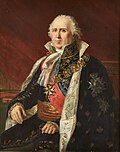 Mattieu d'Auber (1739-1824) |
17th of October, 1822 |
9th of February, 1824 |
Coup d'état | Clementinist | ||
| 2 |  Laurence Dannon (1753-1837) |
9th of February 1824 |
TBD 1825 |
Coup d'état | Legitimist | ||
The Verdon Restoration (1825-1841)
| Portrait | Name | Reign began | Reigned until | Relationship with predecessor(s) | Title | ||
|---|---|---|---|---|---|---|---|
House of Verdon | |||||||

|
His Serene Highness Charles X 1786-1836 |
TBD 1825 |
TBD 1836 |
• Brother of TBD | By the Grace of God, King of the Auvernians | ||
House of Verdon-Soissons | |||||||

|
His Serene Highness Philippe II 1774-1850 |
TBD 1736 |
TBD 1841 |
• Cousin of Charles X • Appointed heir by royal decree by Charles X |
By the Grace of God, King of the Auvernians | ||
Second Clementinian Era (1841-1925)
| Portrait | Name | Reign began | Reigned until | Relationship with predecessor(s) | Title | ||
|---|---|---|---|---|---|---|---|

|
Pierre III 1786-1846 |
29th of August, 1841 |
12th of May, 1846 |
• Brother of Pierre I | Emperor of Auvernia and her colonies | ||

|
Pierre IV 1806-1877 |
12th of May, 1846 | 17th of June, 1877 | • Son of Pierre III | Emperor of Auvernia and her colonies | ||
(1877-1889) | |||||||

|
Jérôme I 1822-1891 |
30th of December, 1889 | 11th of May, 1891 | • Cousin of Pierre IV | Emperor of Auvernia and her colonies | ||

|
Étienne 1864-1925 |
11th of May, 1891 | 27th of June, 1925 | • Son of Jérôme I | Emperor of Auvernia and her colonies | ||
The Emergency Dictatorship (1925-1927)
| Portrait | Term | Mandate | Affiliation | ||||
|---|---|---|---|---|---|---|---|
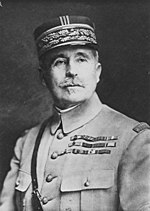 Jean-Claude de Valmère (1856-1929) |
9th of April, 1925 |
18th of March, 1927 |
Majority support of the Auvernian Military High Command | Non-partisan | |||
Second Republican Era (1927-)
Key:
Republican Union Republicanism, Dirigisme, Law and Order
National Republican Republicanism, Social democracy
| No | Portrait | Term | Term | Mandate | Affiliation | ||
|---|---|---|---|---|---|---|---|
 President of the Second Auvernian Republic President of the Second Auvernian Republic  | |||||||
| 1 |  Jean-Claude de Valmère (1856-1929) |
1 | 19th of March, 1927 |
12th of January, 1929 |
Majority popular vote | Republican Union | |
(12th of January to the 19th of March) | |||||||
| 2 |  Clément Sartre (1856-) |
1 | 19th of March, 1929 |
18th of March, 1934 |
Majority popular vote | National Republican | |
| 2 | 19th of March, 1934 |
- | Majority popular vote | National Republican | |||
List of Heads of Government of Auvernia
See main article: List of Heads of Government of Auvernia
Second Imperial Era
(1841-1925)
Key:
Radical Republican Republicanism, Social liberalism
Moderate Republican Constitutional monarchy, Social liberalism
Clementinist Clementinism, Imperialism
| No | Portrait | Term | Term | Mandate | Affiliation | Overview | |
|---|---|---|---|---|---|---|---|
| 1 |  Jean Cazalet (1786 - 1853) |
Single term | 17th of October, 1841 |
28th of October, 1846 |
Republican minority government | Radical Republican | After the elections of 1841 called by Emperor Pierre III, the Clementinists had a weaker showing than anticipated leading to them being unable to bring enough moderates on board to form a government. Instead Jean Cazalet, a political powerhouse among the republicans greatly popular in Auvernia manages to pull together a minority government that despite being radical in its orientation is willing to work with Pierre III. When Pierre IV demands an oath of loyalty in 1846, Cazalet refuses and opts not to run for another term. |
| 2 |  Samuel Cognac (1802-1857) |
Single term | 17th of October, 1846 |
19th of July, 1852 |
Republican minority government | Moderate Republican | Elected from among the Moderate Republicans after they gained the most seats. Initially boasting strong relations with Pierre IV and wishing to bolster the power of the Chamber of Deputies, disputes over war strategy in the ongoing West Nymerian Crisis of 1850. The result was Cognac denouncing Pierre IV a strategically incapable and Pierre IV in return dismissing Cognac as President. Snap elections were held in August after the minority government failed to agree on a new President within the twenty one day window. |
| 3 |  Alan Pierre Laurent (1801-1874) |
Single term | 22nd of August, 1852 |
2nd of September, 1857 |
Clementinist majority government | Clementinist | After a strong showing in the August 11th snap election, the Clementinists managed to win a majority of seats in the Chamber of Deputies but were divided over who to select as their President. After a week of deliberation they settled on Alan Pierre Laurent, son of the Clementinist Wars marshal Alan Laurent and a personal friend of Pierre IV. President Laurent was highly supportive of the Imperial agenda but opted against running for re-election instead intent on serving as president of the Imperial Academy starting in 1857. |
| 4 |  Didier H. Ballard (1810-1865) |
Single term | 22nd of August, 1857 |
8th of April, 1860 |
Republican majority government | Moderate Republican | A retired brigadier general and deputy for Sancy, President Ballard was elected in the strongest showing by republicans only straying four seats from forming a majority government. Nonetheless enough crossbencher non-inscrits voted along with his government that his government functioned as a majority government would. His policies included increasing colonial investments, public schooling and rural infrastructure. A major believer in internal improvements, Ballard's administration also invested in experimental technologies such as the railroad and telegraph. Ultimately, a scandal in which Ballard was found to be attending meetings with exiled radical republicans caused monarchists within his faction to demand that he step down and ultimately to the Emperor dismissing the government and calling an election. |
| 5 |  Emmanuel Montauban (1814-1884) |
Single term | 20nd of April, 1860 |
1st of May, 1865 |
Clementinist minority government | Clementinist | A staunch Clementinist, President Montauban strengthened sedition laws in retaliation for the Ballard scandal leading to Ballard's exile from Auvernia. Despite this he continued most of Ballard's domestic priorities and built on them by supporting the establishment of a national railway network to connect all rail lines in Auvernia. He declined to run for an additional term when the election of 1865 loomed near. |
| 6 |  Richard L. Promeneur (1795-1868) |
Single term | 20nd of April, 1865 |
17th of December, 1868 |
Clementinist majority government | Clementinist | An artist, composer and academic, Richard Promeneur was a personal friend of Emperor Pierre IV and it was at his beheast that the Clementinist faction nominated him to serve as their candidate for president. The result was a popular presidency in which Promeneur would debate the opposition at length in parliament and rallied support for investment in the fine arts, imperial expeditions in Nymera and Tellures leading to colonial exhibitions in Nanterre in 1867 and 1868. Aside from this major naval investments were made and the economy fared well seeing stable growth under a policy of public investiture and limited mercantilism. However, in November of 1868 President Promeneur contracted tuberculosis leading to his health failing to the point of infirmity and his death on December 17th, 1868. |
| 7 |  Pierre de Saverne (1849-) |
1 | 19th of March, 1868 |
18th of March, 1870 |
Clementinist majority government | Clementinist | A political philosopher, member of the supreme court and member of the nobility, Pierre de Saverne was selected to succeed Promeneur. A major revanchist, monarchist and imperialist the first de Saverne administration saw massive military and colonial investment and the outbreak of the First Nāngai War (1869-1871). |
| 2 | 19th of March, 1870 |
19th of March, 1873 |
Clementinist minority government | Clementinist | Receiving lackluster results in the 1870 election, President de Saverne struggled to get his policies implemented during his second administration leading to him calling elections in 1873 amid infighting among the republicans. | ||
| 3 | 19th of March, 1873 |
19th of March, 1881 |
Clementinist majority government | Clementinist | Receiving an electoral supermajority, the third de Saverne administration WIP | ||
Second Republican Era (1927-)
Key:
Republican Union Republicanism, Dirigisme, Law and Order
National Republican Republicanism, Social liberalism, Social liberalism
Federal Syndicalist National Syndicalism, National Catholicism, Subsidiarity, Corporatism
| No | Portrait | Term | Term | Mandate | Affiliation | ||
|---|---|---|---|---|---|---|---|
| 1 |  Mathieu Franchot (1849-) |
1 | 19th of March, 1927 |
18th of March, 1930 |
Republican Union majority government | Republican Union | |
| 2 | 19th of March, 1930 |
19th of March, 1933 |
National Republican minority government | National Republican | |||
| 3 | 19th of March, 1933 |
19th of March, 1936 |
National Republican-MoDem Coalition government | National Republican | |||
| 2 |  Charles Maçay (1874-) |
1 | 19th of March, 1936 |
- | FSP-PT-LR coalition government | Federal Syndicalist | |
Politics
The Politics of Auvernia have been considerably shaped by the Great War and its aftermath, the Auvernian Revolution and the Auvernian Civil War. The Great War itself had considerably weakened Auvernia's geopolitical position, and resulted in the loss of many Auvernian colonies to revolutions and wars of independence. This position of weakness was only further exacerbated by the Auvernian Revolution, which led to the collapse of the Auvernian Commonwealth as many overseas affiliates no longer recognized the Auvernian government. The Revolution's evisceration of the House of Verdon permanently has stifled any monarchist sentiments in the country, though the brutality of the Revolutionaries also inspired the Nanterre Rebellion which eventually led to the Auvernian Civil War. The consequences of these conflicts has been a nation which now is intensely opposed to Communalism and skeptical of Liberalism and Monarchism.
With the success of the National Syndicalists in the first election after the Civil War and the one year presidency of retired Great War General Laurent Perrier, the nation was fundamentally transformed, abandoning a strict adherence towards a unitary government towards federalism and further turning away from strict assimilationism and instead persuing a new policy known as patrimonialism which recognizes regional dialects and cultures while maintaining a national standard for Auvernian language and encouraging common trends which make the different constituent regions of Auvernia similar. (For further reading, see main article: Politics of Auvernia)
Political Parties in the Second Auvernian Republic, 1935-
There are several notable political parties in the Second Auvernian Republic, the dominant center-left Front Républicain (FR) their coalition partner the centrist Mouvement Démocrate (MoDem), the free-market Parti Libéral (PL), the Parti Fédéral-Syndicaliste (PFS), the Parti Traditionaliste (PT) and the Ligue Patriotique (LP).
In addition to the major parties are some smaller parties with a presence in national politics, namely the once major syndicalist party, the RTC-FRS, as well as the Parti Réformiste and the 'Non Affiliés' which consist of registered independents and parties that have not exceeded the threshold to be registered nationally. In addition to these there exist parties with limited regional representation.
(For further reading, see main article: Politics of Auvernia)
Foreign Relations
(For further reading, see main article: Foreign Relations of the Auvernian Federation)
Armed Forces
(For further reading, see main article: Armed Forces of the Auvernian Federation)
Army
(For further reading, see main article: Auvernian Federal Army)
The Auvernian Army is the land-based component of the Auvernian Armed Forces, and represents the largest portion of its personnel. It is responsible to the Government of the Auvernian Federation and headed by the Chief of the Auvernian Army, Maurice Pelley, who reports to the Minister of War Vincent Rose, who reports directly to the President of the Auvernian Federation.
As of 1934, the Auvernian Army employs 381,330 personnel including the Army Air Corps, Auvernian Foreign Legion, National Guard and Auvernian Colonial Infantry. Though limited conscription exists in Auvernia, the Auvernian Army is a majority volunteer force and therefore soldiers are considered professionals.
(For further reading, see main article: Auvernian Federal Navy)
Air Force
(For further reading, see main article: Auvernian Air Force)
Gendarmerie
Demographics
(For further reading, see main article: Demographics of Auvernia)
Ethnic Groups
The Auvernian Federation classifies ethnic groups along two lines "Ethnic Groups" and "Ethno-Cultural Groups". Ethnic groups are seen to be racial in nature, and to represent a distinct ethnic polity, whereas ethno-cultural groups are seen to be further divided based upon historic cultural and linguistic distinctions. In Auvernia, the field of Generative Anthropology has driven this move, and has led to an understanding of Auvernians as having diverged in part due to discrete differences in the ethno-cultural heritage of Auvernians in different areas of the country. For example, the Maritimois retain a greater degree of linguistic and cultural connection to Aventine cultural roots that have disappeared in other regions and Ouest-Auvernes lack some Altic cultural influences present among the average Auverne.
Languages
Within ethno-cultural groups, there exist regional dialects. In the past such dialects were actively discouraged by the state and even persecuted. However, since the foundation of the Federation, a transition from aggressive assimilationism towards patrimonialism has led to a largely bilingual Auvernia in which standard Auvernia is coupled with local dialects. Such dialects have begun the process of standardization and the Académie Nationale des Langues Auverniennes (ANLA) has worked to catalog and formulate a method for formally teaching dialects in schools. However, with the exception of Fankiz and Ostian, foreign languages are not promoted by the Auvernian state, though they are not actively persecuted either.
Migration
Immigration to Auvernia is highly controlled and strict quotas are set annually to limit immigration based upon economic and social indicators. Those wishing to immigrate to Auvernia face a rigorous background check, are required to speak Standard Auvernian, and are not granted citizenship unless they serve in the military during wartime or pass a citizenship test after ten years of residency in the country. This high standard is set in part to control the labor pool supply in Auvernia, as high levels of immigration are seen by Auvernian labor syndicates as threatening to sustainable wage increases due to labor competition.
Immigration to the colonies is promoted to working class Auvernians, especially those working in agriculture. Land grants, colonial farming subsidies and corporate partnerships are organized annually to encourage such immigration, and as such a large portion of the Auvernian colonies are ethnic Auvernians. Immigration from the colonies back to Auvernia is generally restricted to only those who are Auvernian as the colonies have lower standards for immigration than metropolitan Auvernia. Such standards allow for Cybellans and even Tellurans to immigrate to the colonies, and for colonials to immigrate between colonies, with relative ease.
Emigration from Auvernia is relatively low, though most emigration aside from emigration to the colonies is seen in emigration to former colonies, such as Duquesne, or to stable Hibernian and Aestian countries.
Healthcare
Healthcare in Auvernia is universally ensured by the Service de Santé National (SSN) which was established in 1931. In its first years of operation, the SSN has already exceeded initial expectations for expenditure cost, however, a dividend on oil produced in colonies coupled with excise taxes on alcohol and tobacco have been implemented to help offset the high price of healthcare. However, signs of notable progress have been seen in the aftermath of this massive reform, and with high wages for doctors in the country, Auvernia has begun to set a global standard for healthcare. In particular investments in mass-vaccination schemes have reduced deaths from smallpox and other similar diseases. The SSN ensures all Auvernian citizens and legally authorized long term residents, while highly regulated private healthcare companies exist to supplement the SSN and to provide healthcare for temporary workers in the country.
Education
Education is organized federally by the Ministry of Education, which sets federal guidelines that mandate what are known as 'core skills'. These being Standard Auvernian grammar and literature, History & Civics, Family and Consumer Sciences, Physical Education, Mathematics, and Applied Science. The Ministry mandates all children aged 5 through 14 attend schooling, though providing for children to continue schooling until the age of 17. These age groups are broken down by age and categorized into four segments, Preparatory School for children ages five through seven, Elementary School for children aged eight through ten, Secondary School for children ages eleven through fourteen, and Lycée for children fifteen through seventeen.
Regional governments supplement this education with curricula which cater to their regional interests, such as providing options to learn different artisan skills such as woodworking and mechanical work, and regional dialect classes.
Males who attend Lycée are mandated to join the Young Pioneers of Auvernia, a national civics organization sponsored by the government, corporate interests groups and the Auvernian Branch Catholic Church. The Young Pioneers of Auvernia is open to children from the age of eight and encouraged to provide children with an outlet for physical activities and to provide cultural enrichment for the youth. The Young Pioneers engage in natural conservation projects, and are an integral part of major cultural events and national holidays. Lycée Cadets in the Young Pioneers are further given classes in orienteering and marksmanship to prepare them for military conscription.
Economy
(For further reading, see main article: Economics of Auvernia)
The Auvernian economy is a mixed market economy in which there exists a corporatist system involving a tripartite arrangement where representatives of labor syndicates and private enterprises negotiate wages. Labor market policy is mediated by the government and with a large percentage of the workforce unionized, serves to control the value of labor to ensure a high quality of life for working class citizens. This state economic intervention is paired with high tariffs on foreign goods, subsidies for domestic enterprises and investment in infrastructure, particularly agricultural and industrial infrastructure. Furthermore, the Auvernian economy is composed with the intention of tying Auvernia to its remaining colonies and creating a state of co-dependence. Through colonial investments in infrastructure and education, the Auvernian Federation aims to increase standards of living throughout its global holdings and to ensure stability within its sphere of influence.
In the aftermath of the election of President Clément Sartre, emphasis was put on creating new 'Communes Centralisées', or cluster communities. These have manifested in several massive projects to create cities based upon traditional Auvernian architecture in which clustered villages come together to create sprawling sub-urban cities. These have been touted by the Auvernian administration as being far more in line with the cultural heritage of the Auvernian landscape and a move away from the "garish" modern cities that have emerged. To couple this new movement in urban planning, the government has further announced massive plans aimed at urban renewal in industrial areas of the country that are aimed at reducing pollution and increasing the number of urban parks and tree coverage. The Organisation de Conservation Civile (OCC) has been tasked with these projects in addition to hydroelectric power projects, and expanding rail lines, intercity roads and the electrification of rural communities.
Furthermore, while maintaining the protectionism of his predecessor, President Clément Sartre has begun working on creating an economic partnership with Nørräland, Baranda and Luistia, and has engaged in economic normalization of relations with Altenland and Duquesne. However, these are widely seen as geo-political maneuvers rather than a transition towards free-trade and President Sartre has indicated that such moves will be taken carefully with the Auvernian worker in mind first and foremost.
Science and Technology
Energy
Oil and Gasoline
Coal
Transport
(For further reading, see main article: Transportation in Auvernia)
Railroad
Air Travel
Airports
Airlines
Automotive Industry
Culture
(For further reading, see main article: Auvernian Culture)
Dress
Men
Women
Literature
(For further reading, see main article: Auvernian Literature)
Media
Television
Radio
Movies
Music
Sport
Symbols
Public holidays
| Date | Name | Holiday | Notes |
|---|---|---|---|
| 1 January | Feast of the Circumcision of Christ | New Year's Day | |
| 2 January | Feast of the Holy Name of Jesus | ||
| 6 January | Epiphany | ||
| 2 February | Candlemas | ||
| 22 February | Feast of the Chair of Saint Peter | ||
| 19 March | Saint Joseph's Day | ||
| 25 March | Feast of the Annunciation | ||
| movable Thursday | Maundy Thursday | The Thursday Easter Sunday | |
| movable Friday | Good Friday | The Friday before Easter Sunday | |
| movable Saturday | Holy Saturday | The Saturday Easter Sunday | |
| movable Sunday | Easter Sunday | First Sunday after the Ecclesiastical full moon that occurs on or soonest after 21 March | |
| movable Monday-Saturday | Ebdomada Alba | Week following Easter | |
| movable Sunday | Quasimodo Sunday | Sunday After Easter | |
| movable Thursday | Feast of the Ascension | 40 days after Easter | |
| movable Sunday | Pentecost | 50 Days after Easter | |
| moveable Friday | Feast of the Sacred Heart | 19 Days after Pentecost | |
| 29 May | Corpus Christi | ||
| 31 May | Visitation | ||
| 24 June | Nativity of John the Baptist | ||
| 29 June | Feast of Saints Peter and Paul | ||
| 15 August | Assumption of Mary | ||
| 22 August | Immaculate Heart of Mary | ||
| 8 September | Nativity of Mary | ||
| 14 September | Feast of the Cross | ||
| 1 November | All Saints' Day | ||
| 2 November | All Souls' Day | ||
| 21 November | Presentation of Mary | ||
| Movable Sunday | Feast of Christ the King | Last Sunday of October | |
| 21 November | Immaculate Conception | ||
| 24 December | Nativity's Eve | ||
| 25 December | Nativity | ||
| 26 December | St. Stephen's Day | ||
| 27 December | Feast of St. John |



